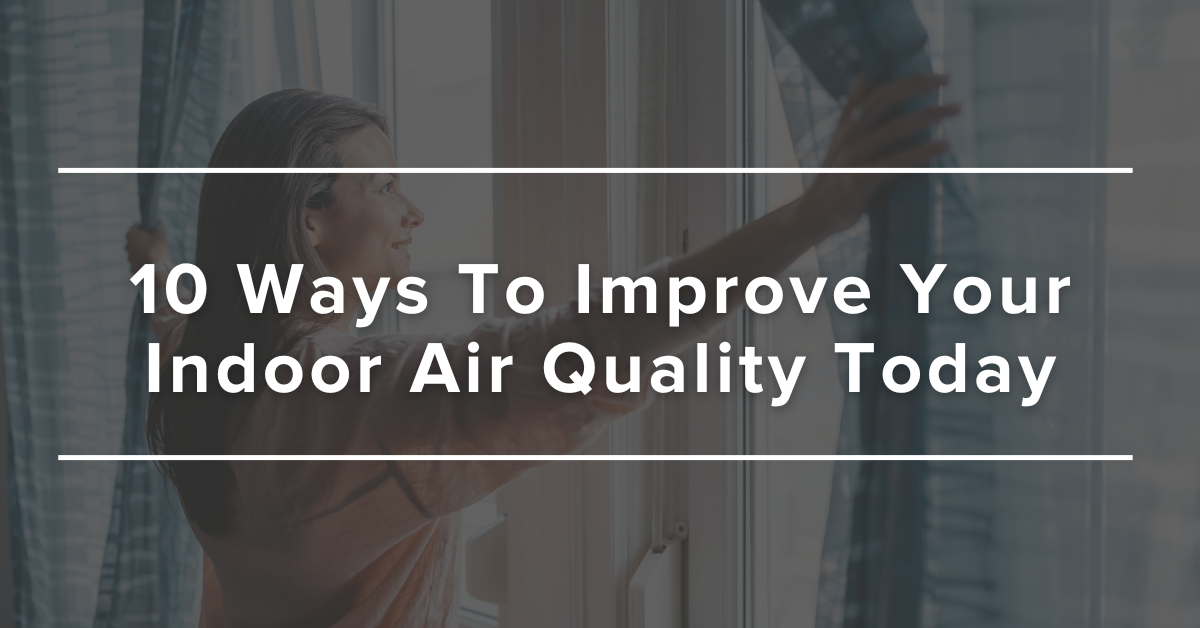
No matter where you live, air pollution is an unavoidable part of modern life. From vehicle emissions and industrial activity to volcanic eruptions and household products, pollutants find their way into the air we breathe every day. While we can’t completely escape exposure, we can take steps to improve the quality of the air in our personal environments. Here are our top ten ways to clean up your air, protect your respiratory health and boost your overall well-being!
1. Keep The Air Moving
Unfortunately, most heating and cooling systems do not bring enough fresh air into the home. Keeping a good ventilation rate throughout the home is one of the best ways to prevent stagnant air and filter bacteria out of the home. Things like opening windows and running ceiling or bathroom fans can help keep the air in your home flowing.
2. Invest In An Air Purifier
Air purifiers are an excellent tool for improving your indoor air quality. For the best results, look for one equipped with a HEPA filter. HEPA filters are highly effective at capturing microscopic particles such as dust, pollen, smoke, and pet dander. If you’re also concerned about odors or airborne chemicals, consider a purifier that includes a carbon filter—these are designed to absorb gases and eliminate unpleasant smells.
3. Clean Your Home
This seems like a no-brainer, but with busy schedules it can be hard to keep up with regular cleaning. Keeping a clean home is one of the best steps towards healthier indoor air. Carpets are notorious for trapping pet hair, dust and dirt. Keeping a regular vacuuming routine will help keep these allergens at bay. Wiping down surfaces and washing your bedding often are also great ways to rid your home of unwanted allergens. Just be sure to avoid using cleaning products with harsh chemicals.
4. Live Low-Tox
Many common household items and habits are actually sneaky air quality disruptors. An obvious one is smoking indoors. Tobacco smoke can stay trapped in carpet and upholstery for a long time. Other things like candles and incense can actually release VOCs ( Volatile Organic Compounds) even though they temporarily improve the smell of your home. Opting for candles made from beeswax or soy and essential oils are cleaner options. Swapping out cleaning products with ones made from more natural ingredients is another good way to make sure you are not polluting the air with chemicals.
5. Add A Touch of Green
Indoor plants are nature’s detoxifiers. Plants like peace lilies, snake and spider plants are all natural air purifiers. These green superheros absorb toxins and release fresh oxygen into the air, giving your indoor air a fresh outdoor feel. It is important to take good care of your plants, as bad soil can negatively affect the air.
6. Get Smart About Your Air
Using an indoor air quality monitor provides valuable insight into the air you breathe every day. These devices measure key pollutants like particulate matter, volatile organic compounds (VOCs), and carbon dioxide—giving you a clearer picture of what might be affecting your indoor environment. With real-time data and alerts, you can quickly identify problem areas, take action to reduce pollution sources, and make informed decisions about ventilation, air purifiers, or household products.
7. Use An Air Exchange System
Air exchange systems help maintain a healthy indoor environment by continuously replacing stale indoor air with fresh outdoor air. These systems are especially important in well-sealed, energy-efficient homes where natural airflow is limited. By reducing the buildup of pollutants, excess humidity, and odors, air exchange systems improve indoor air quality while also helping regulate temperature and energy efficiency.
8. Ventilate While You Cook
Gas stoves and even electric burners can emit harmful substances such as carbon monoxide and nitrogen dioxide. It’s easy to remember to turn on your oven’s vent fan when the kitchen is smoky but these other gases are not as noticeable and just as damaging to your indoor air quality.
9. Check Your Ducts and Air Filters
Your air ducts and air filters are also sneaky sources of poor air quality. If not properly installed, cleaned, and maintained, air ducts and air filters can build up and distribute dust and other allergens throughout the home. Over time, this can contribute to respiratory issues, worsen allergy symptoms, and reduce the overall efficiency of your HVAC system.
10. Schedule Regular Professional Maintenance
The best thing you can do to keep your home healthy and your indoor air quality pristine is to schedule regular hvac maintenance. With our maintenance plan, you will never forget to keep up with your hvac system and will keep your indoor air quality at a ten year round!

